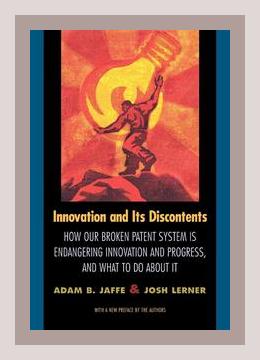Business Law and EthicsIntellectual Property
Innovation and Its Discontents: How Our Broken Patent System is Endangering Innovation and Progress, and What to Do About It by Adam B. Jaffe, Josh Lerner (2007) – Summary
Introduction
In “Innovation and Its Discontents,” Adam B. Jaffe and Josh Lerner critique the current state of the United States patent system. They argue that the system, designed to encourage innovation by protecting intellectual property, has paradoxically begun to stifle it. This comprehensive summary will explore the main points and examples from the book, suggesting actionable steps for individuals and policymakers.
1. Background and Purpose of the Patent System
The primary goal of the patent system is to encourage innovation by granting inventors exclusive rights to their inventions for a limited time. This monopoly incentivizes investment in research and development by ensuring potential financial returns.
Actionable Step:
– Understand the Patent System’s Original Intent: Innovators should familiarize themselves with the foundational principles of the patent system to better navigate its complexities and use it to their advantage.
2. The Transformation and Decline of the Patent System
Jaffe and Lerner argue that starting in the 1980s, significant changes in the U.S. patent system have led to its decline. They discuss the establishment of the Court of Appeals for the Federal Circuit (CAFC) in 1982, which centralized patent appeals and became pro-patent, leading to a more permissive environment.
Actionable Step:
– Stay Informed on Legal Changes: Entrepreneurs and inventors should regularly follow updates in patent law to understand how shifts in legal interpretations may impact their inventions.
3. Overburdened Patent Office
The USPTO has become overwhelmed with the sheer volume of patent applications, leading to insufficient examination quality. The authors highlight that underfunding and inadequate staffing have resulted in numerous low-quality patents being approved.
Concrete Example:
The book cites instances of dubious patents, like the infamous Amazon 1-Click patent, which critics argue lacked significant novelty.
Actionable Step:
– Conduct Thorough Patent Searches: Before filing a patent, inventors should perform extensive searches to check for prior art, thereby increasing the quality of applications and reducing potential legal battles.
4. Strategic Patenting and ‘Patent Trolls’
The rise of strategic patenting and non-practicing entities (“patent trolls”) is underscored as a significant problem. These entities obtain patents solely to extort money from practicing companies via litigation threats.
Concrete Example:
Jaffe and Lerner discuss the case of NTP Inc. suing Research In Motion (RIM), the maker of BlackBerry, leading to a $612.5 million settlement despite NTP not producing any of their patented inventions.
Actionable Step:
– Mitigate Litigation Risk: Companies should consider patent insurance or be prepared with defensive patenting strategies to protect themselves from potential litigation by entities seeking to exploit the system.
5. Impact on Technological Innovation
The tangled web of patents, especially in fast-moving fields like electronics and software, creates a “patent thicket,” making it difficult for innovators to develop new products without risking infringement.
Concrete Example:
The complexity and high costs of navigating patent portfolios are illustrated through the smartphone industry, where companies like Apple and Samsung engage in extensive patent warfare.
Actionable Step:
– Utilize Open Innovation Models: Businesses should consider participating in patent pools or open-source projects to reduce the risk of infringement and foster collaborative innovation.
6. International Implications
The authors discuss the global ramifications, noting that other countries often mimic the U.S. system, amplifying the consequences worldwide. Moreover, excessive patenting can lead to innovation slowdowns, especially in developing nations that can’t afford litigation costs.
Concrete Example:
The biotechnology sector is highlighted, where strict patenting in the U.S. affects global access to crucial agricultural advancements.
Actionable Step:
– Engage in Global Best Practices: Innovators should study and adopt international best practices from countries with more balanced patent systems, aiming to create synergies and avoid pitfalls.
7. Proposed Reforms
Jaffe and Lerner propose several reforms to address these issues:
- Enhanced Patent Office Funding: Increasing resources to the USPTO to improve examination quality.
- Post-Grant Opposition: Implementing a robust post-grant review process to allow for the challenging of patents shortly after they are issued.
- Heightened Requirements for Patentability: Raising the bar for novelty and non-obviousness to ensure higher-quality patents.
- Limiting Injunctive Relief: Reducing the automatic issuance of injunctions in infringement cases to prevent abuse by patent trolls.
- Hybrid System: Combining the best practices of the U.S. and European systems.
Actionable Step:
– Advocate for Policy Change: Innovators and businesses should engage in policy advocacy to support reforms. This can include lobbying efforts, participating in public consultations, and collaborating with trade associations to drive legislative changes.
8. Individual and Organizational Strategies
The book suggests strategies for both individuals and organizations to navigate the flawed patent system effectively:
- For Individuals: Innovators should seek high-quality legal advice when filing patents and consider alternative protections like trade secrets when appropriate.
Actionable Step:
– Seek Expert Advice: Engaging with experienced patent attorneys can provide invaluable guidance on filing robust patent applications and strategically managing a patent portfolio.
- For Companies: Firms should invest in developing comprehensive intellectual property strategies that include proactive patent monitoring, defensive portfolios, and active participation in industry consortia.
Concrete Example:
Large corporations, such as IBM, have vast patent portfolios used both defensively and for cross-licensing opportunities, exemplifying strategic IP management.
Actionable Step:
– Develop an IP Strategy: Companies should allocate resources to build and manage a strategic intellectual property portfolio, ensuring it aligns with their broader business goals.
Conclusion
Jaffe and Lerner’s “Innovation and Its Discontents” highlights the paradox where a system designed to foster innovation is increasingly hindering it due to structural flaws and exploitative practices. By understanding these challenges and adopting the actionable steps suggested above, inventors and policymakers can work toward a more balanced and effective patent system that truly stimulates innovation and progress.
